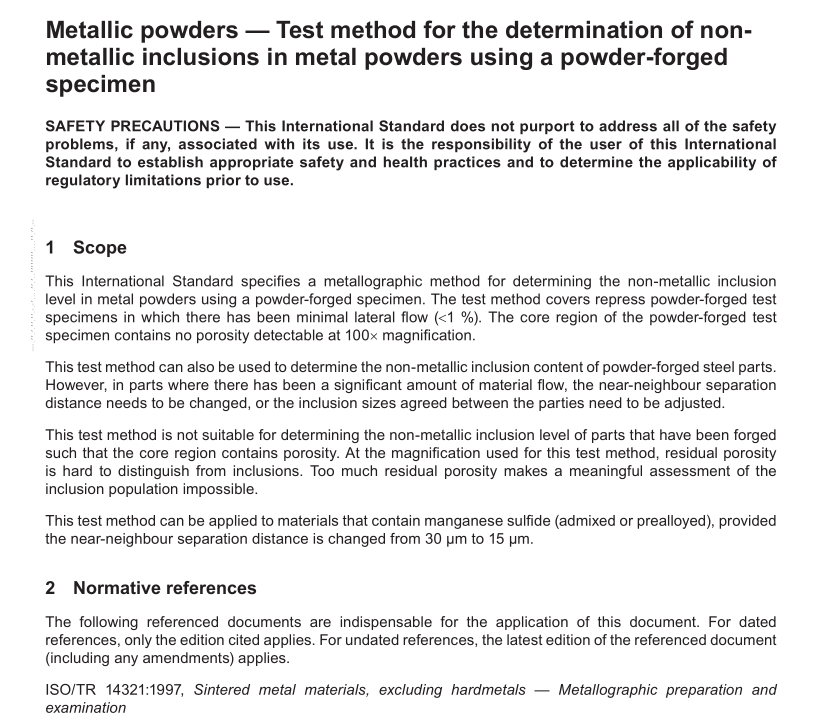ISO 13947 pdf download

ISO 13947 pdf download Metallic powders — Test method for the determination of non-metallic inclusions in metal powders using a powder-forged specimen
The maximum Feret’s diameter is used to determine inclusion size.A Feret’s diameter is a caliper diameter, asillustrated in Figure 1.
The fragmented nature of some inclusions means that their size determination is somewhat complicated.Theconcept of near-neighbour separation shall be used in determining inclusion size. According to this concept,ifan inclusion is within a certain distance of its neighbouring particles it is considered a member of an inclusioncluster or agglomerate. Detected features within 30 um of one another are considered part of the sameinclusion.The concept is illustrated schematically in Figure 2.
The non-metallic inclusion level of the test specimen (part) is reported as the number of inclusions, per100 mm2, greater than or equal to the predetermined size.
4Significance and use
4.1The non-metallic inclusion level of ferrous powders is an indication of powder cleanliness. In pressed andsintered ferrous powder metallurgy (PM) materials , the extensive porosity present masks the effect of inclusionson mechanical properties. In contrast, the properties of a PM material processed to near pore-free density arestrongly influenced by the composition, size, size distribution, and location of non-metallic inclusions.
4.2The test for non-metallic inclusions in fully dense steel parts is useful as
a characteristic to classify or differentiate one grade of powder or batch of parts from another, anda lot-to-lot quality comparison of powders intended for powder forging.
4.3Asignificant amount of variation in non-metallic inclusion content will occur
if the powder used to form the test specimen (part) does not meet the required quality standards for non-metallic inclusion content, or
processing of the test specimen (part) has been carried out under conditions that do not permit oxidereduction or allow oxidation of the test specimen (part), or both.
4.4The use of the near-neighbour concept offers a more conservative estimate of the inclusions : it wloverestimate rather than underestimate them.
5 Apparatus
5.1 Equipment, for the metallographic preparation of test specimens.
5.2Metallographic microscope, permitting observation and measurement up to a magnification of 100xusing light with a wavelength of 544 nm (green filter), an objective lens with a magnification ranging from 8x to12,5x。and a numerical aperture between0.16 and 0.20.
NOTE Defining the light optics used is important because this determines the features that will be resolved, and alldetecled features are included in the assessment of inclusion size.
6 Test piece
6.1For the evaluation of the non-metallic inclusion content of a powder that is intended for use in powder-forging applications, the powder shall be mixed with an appropriate amount of graphite and lubricant andcompacted to a specified green density. The test method covers repress powder-forged test specimens in whichthere has been minimal lateral flow (<1 %) so the diameter of the green compact shall be such, relative to thediameter of the forging die, that this requirement is met.
6.2 A metallographic specimen shall be removed from the powder-forged test specimen (part), austenitized and quenched. Hardening of the specimen facilitates sample preparation by preventing smearing of soft inclusions and scratching.
6.3 The polished surface of the specimen (part) to be examined shall be not less than 350 mm 2 in area. Multiple sections are permitted in order to obtain the necessary area for measurement on small parts.
6.4 The polished surface shall be parallel to the direction of working; that is, parallel to the direction of travel of the forging tools, and shall represent the core region of the test specimen (part).
7 Procedure
7.1 Preparation of specimens In polishing the specimens, it is highly important that a clean polish be obtained and that the inclusions not be pitted, dragged or obscured. It is therefore recommended that the procedures described in ASTM E3 and ASTM E768 be followed. Automated grinding and polishing procedures are recommended. Examine specimens in the as-polished condition, free of the effects of any prior etching (if used). ISO/TR 14321:1997 shall be followed.
7.2 Measurement of non-metallic inclusion content
7.2.1 Survey at least 350 mm 2 of the surface of the polished specimen at a magnifcation of 100× using light with a wavelength of 544 nm (green flter), an objective lens with a magnifcation ranging from 8× to 12,5× and a numerical aperture between 0,16 and 0,20.
7.2.2 Size the detected inclusions on the basis of near-neighbour separation. Features within 30 µm (0,03 mm) of one another (within 3 mm of one another at 100× magnifcation) are considered to be part of the same inclusion. 7.2.3 For individual features of less than 30 µm in size, three such features within 30 µm of one another are required to constitute an inclusion aggregate, when the near-neighbour separation principle is used.









